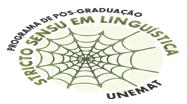Banca de DEFESA: JOÃO RENATO DOS SANTOS JUNIOR
Uma banca de DEFESA de DOUTORADO foi cadastrada pelo programa.DISCENTE : JOÃO RENATO DOS SANTOS JUNIOR
DATA : 29/09/2025
HORA: 14:00
LOCAL: Videoconferência
TÍTULO:
TOPONYMY IN LIBRAS: THE COLLABORATIVE CONSTRUCTION OF A BILINGUAL DIDACTIC PROPOSAL FOR THE EDUCATION OF DEAF STUDENTS
PALAVRAS-CHAVES:
Toponymy in Libras; Bilingual Deaf Education; Interdisciplinarity; Applied Linguistics.
PÁGINAS: 130
GRANDE ÁREA: Lingüística, Letras e Artes
ÁREA: Lingüística
SUBÁREA: Lingüística Aplicada
RESUMO:
This research, developed within the field of Applied Linguistics, in the research line "Studies of Social Language Practice Processes" of the Graduate Program in Linguistics (PPGL), aims to analyze to what extent the planning carried out by deaf teachers for the teaching of Toponymy, in a collaborative and bilingual perspective, influences the development of pedagogical proposals that take into account the linguistic, cultural, and didactic-methodological aspects of Deaf Education. The guiding research question is: To what extent does the planning of the work of deaf teachers, conducted in a collaborative and bilingual perspective, influence the development of pedagogical proposals for the teaching of Toponymy that consider the linguistic, cultural, and didactic-methodological aspects of Deaf Education? The study is grounded in Rajagopalan (2003, 2006), Moita Lopes (1996, 2006), Fazenda (1999; 2015), and Sousa (2019, 2022), articulating contributions from Applied Linguistics, bilingual education, toponymy, and interdisciplinarity. Methodologically, it is an action research project involving four deaf teachers (two men and two women) from Rio Branco, Acre. Initially, a didactic proposal involving toponymy in Brazilian Sign Language (Libras) from an interdisciplinary perspective was presented, which underwent workshops, discussions, and collaborative refinement processes. The results indicate that the final rewritten proposal incorporated practices that strengthened deaf teachers' protagonism and autonomy, articulated interdisciplinarity with the principles of critical Applied Linguistics, and included visual and cultural elements specific to the Deaf community. It was found that collaboration among deaf peers and bilingual planning enhance the possibilities for creating more meaningful and contextualized pedagogical proposals for the teaching of Toponymy, as well as contribute to more inclusive and culturally responsive educational practices. It is concluded that collaborative planning processes, when centered on the knowledge and experiences of deaf teachers, represent powerful pathways for strengthening bilingual education and for valuing Libras as a language of instruction.
MEMBROS DA BANCA:
Presidente - 466.104.133-04 - ALEXANDRE MELO DE SOUSA - UFAC
Interna - 132146001 - BARBARA CRISTINA GALLARDO
Interno - 020.853.382-67 - RODRIGO DE SANTANA SILVA -
Externa à Instituição - LILIANE LEMOS SANTANA BARREIROS - UEFS
Externa à Instituição - ROSANE GARCIA SILVA - UFAC



